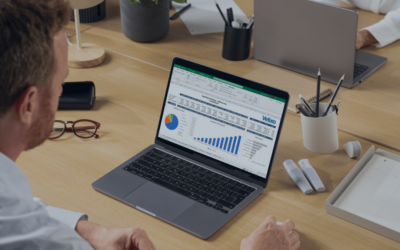Enterprise resource planning (ERP) systems are crucial for companies looking to simplify various business processes, such as HR, accounting, project management, and inventory and order handling. A successful ERP implementation plan is necessary to make the most of your ERP solution and enhance your operational efficiency.
Success requires understanding the following phases of ERP implementation:
- Discovery and planning
- Configuration
- Development and customization
- Data migration and testing
- Training and change management
- Deployment and go-live
- Post-implementation support
This article will help you understand ERP implementation by exploring these phases in greater depth. Let’s get started!
Phase 1: Discovery and Planning
An ERP implementation project begins with the discovery and planning phase. This phase originates during the sales process and requires you to define the objectives and scope of your ERP implementation. In this phase, you develop your project team and meet with these individuals to create a cohesive project plan.
The team works together to identify issues and solutions for ERP implementation. Once you’ve assembled a cross-functional implementation team, you can thoroughly analyze your business processes to determine potential challenges and risks that may emerge during implementation and strategies to address them.
This is also the stage where you can develop a cohesive project plan, timeline, and budget. You and your team members can create additional requirements for implementation based on your company’s specific needs from your ERP solution.
As you connect with ERP vendors, request, and review proposals to determine how each vendor can suit your organizational needs. Conduct various ERP demonstrations and proof-of-concept exercises before selecting an ERP system. Before moving on to the second phase, choose an ERP solution that best aligns with your organizational goals.
Phase 2: Configuration
The second phase in implementing an ERP system is the configuration phase. Also known as the design phase, this step involves tailoring your ERP system to match your organizational processes. Configuration is essential to guarantee that your ERP solution is tailored to your business processes. To begin, map out your workflows and data flow. This stage requires you to define user roles, individual permissions, and access levels based on whether an individual can access your ERP system.
The second phase of ERP implementation also involves integrating your ERP system with your company’s current software and databases to meet ongoing business requirements effectively. This stage requires you to establish your data migration strategies for effective data management as you transition from your current system to your new ERP system.
Phase 3: Development and Customization
The development phase for enterprise resource planning systems requires you to continue developing and customizing required system functionalities that aren’t already available in your ERP solution. Creating tailored solutions that aren’t available out of the box is sometimes necessary to make the most of your ERP system.
During this phase, you must conduct thorough system testing and analysis to ensure your customizations meet the desired objectives. Analyzing your system’s effectiveness and making necessary adjustments is possible through data validation and cleansing activities.
ERP partners like Intelligent Technologies can help you strike a balance between thoughtful customizations that bring real value and over customization, which is notorious for leading to project delays and budget overruns.
Phase 4: Data Migration and Testing
The fourth ERP implementation phase is the data migration and testing process, which is crucial to your solution’s effectiveness. Before migrating your data, ensure that it is cleaned and formatted correctly. Validate and reconcile your data to ensure it’s accurate and complete.
Keep the following processes in mind:
- Plan your data migration carefully: Guarantee that you have a comprehensive migration strategy and understand your ERP project requirements to ensure an efficient transfer of information from your legacy systems to your new ERP solution.
- Cleanse and validate your data: Ensure that data is consistent and accurate before beginning migration. Clean and organize the data thoroughly.
- Perform test migrations: You can ensure your implementation is successful by executing a pilot data migration, using a smaller subset of data to identify bottlenecks before full-scale migration.
- Conduct comprehensive system testing: Test your system through functional, integration, and performance testing. Identify issues through these tests and resolve problems before moving forward.
Phase 5: Training and Change Management
A thorough user training plan is essential to guarantee that employees at all levels of your organization understand your new system. Training sessions should focus on using the ERP system effectively and correctly. A helpful ERP partner will prepare the required user training materials for you to ensure that your team can adapt easily during post-implementation. These materials might include user manuals, hands-on training sessions, or online training modules.
During this phase, emphasize the benefits of your new ERP system, as this can encourage user adoption and lower resistance to change. If employees are hesitant to adopt this solution, implement change management strategies to mitigate issues caused by change resistance. Address any concerns from your employees by providing ongoing training and support.
Phase 6: Deployment and Go-Live
Phase six begins by finalizing your data migration from your legacy system to your new ERP system. Verify that your system is ready for production before the scheduled go-live. Ensure that your go-live is well-planned, setting a specific deployment date at a time that will cause minimal disruption or downtime to business operations. Consider implementing a controlled strategy and deploying your ERP system in smaller phases.
Once you’ve deployed your system, continuously monitor your progress and system performance. Identify and address immediate issues and establish a thorough support system to promote success and address ongoing issues. This support is especially crucial to help users during the initial days of ERP deployment when everyone is still adjusting to the change.
Phase 7: Post-Implementation Support
Ongoing support is crucial to ensure a successful ERP implementation and adoption. Depending on your system requirements and processes, your team might face various adoption issues when adjusting to the new system. Consistently collect feedback from your users about the system’s performance to identify areas for improvement and optimization.
Another way to provide consistent post-implementation support is to conduct frequent audits and reviews of your ERP system processes. This step identifies potential problems, giving you direction when implementing future updates, patches, and necessary enhancements. As you continue using your new system, keep monitoring your ROI and the impact of your ERP solution.
Conclusion
The following are the seven core phases of ERP implementation:
- Discovery and planning
- Configuration
- Development and customization
- Data migration and testing
- Training and change management
- Deployment and go-live
- Post-implementation support
Each phase is crucial to ensure a successful implementation process and user adoption of your new ERP system. ERP management and enhancement is an ongoing process and often requires guidance from an ERP partner equipped to help you manage your new system like Intelligent Technologies.
Businesses should consider ERP implementation as a strategic investment to enhance their organizational operations. You can find out more about successfully implementing an ERP system by downloading our eBook here.



